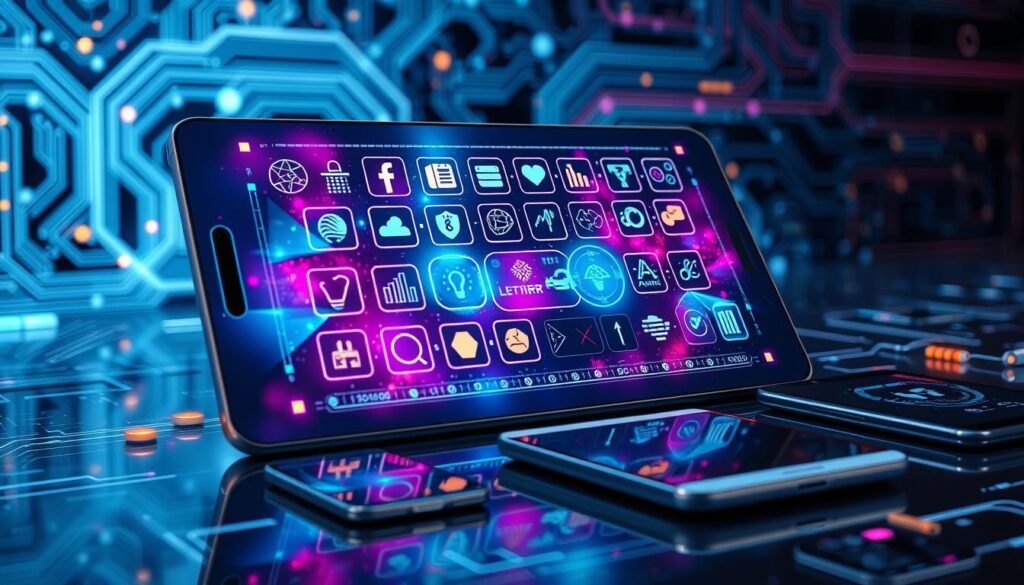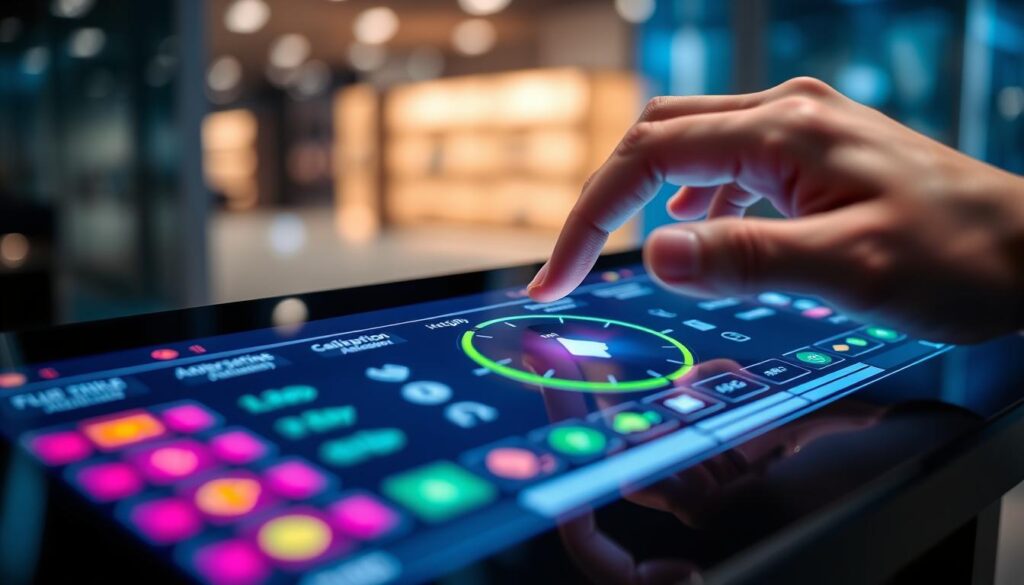Touch screen technology has changed how we use electronic devices. It’s used in everything from smartphones to cash registers. A touch screen is a screen that you can use to interact with devices by touching it.
This technology has grown a lot over time. Now, we have different types of touch screens. They are a big part of our daily lives.
Let’s look at how touch screen technology works and its uses. It started in the 1960s and has grown a lot. Engineers like Frank Beck and Bent Stumpe helped make touch screens better in the 1970s.
Now, touch screens are in many devices. They make our lives easier and have changed the tech world a lot.

As we learn more about touch screens, we’ll see how they work. There are many types of touch screens now. They make using devices easier and more fun.
Touch screens are in many things we use every day. They are important for our daily lives. They have made a big difference in the tech world.
Key Takeaways
- Touch screen technology has revolutionized the way we interact with electronic devices.
- Touch screens are electronic display screens that also serve as input devices.
- Capacitive, resistive, and surface acoustic wave touch screens are common types of touch screen technology.
- Touch screen software or hardware is an integral part of our daily lives, with applications in various devices.
- The tech industry has seen significant growth with the development of new touch screen technologies.
- Understanding touch screen software or hardware is essential to appreciating the intricacies of this technology.
Understanding Touch Screen Technology Fundamentals
Touch screen technology has changed how we use devices. It makes interacting with them easy and fun. At its heart, touch screens use interactive display solutions to sense and react to our touch.
The touch panel is a key part of touch screens. It sits on top of the screen of a device. It catches our touch, like tapping or swiping, and sends it to the controller.
The controller then figures out what we want. It sends this information to the operating system. The system then knows what to do next. This all works because of the touch screen design.
There are different types of touch screens, like resistive, capacitive, and infrared. Each has its own good points and bad points. For example, capacitive screens are very good at handling many touches at once. They’re great for interactive display solutions like phones and tablets.
Resistive screens, on the other hand, are tough and work well with a stylus or even a gloved hand. They’re perfect for places like factories or hospitals. Knowing how touch screens work helps developers make better touch screen design solutions. This makes using devices more fun and easy.
The Hardware Components of Touch Screen Systems
Touch screens are everywhere today, from smartphones to laptops. They use touch panels to work. The key parts are the display, touch panel, and controller.
The touch panel is very important. There are different types like capacitive, resistive, and surface acoustic wave. Capacitive touch panels are in phones and tablets. Resistive touch panels are used in industrial and medical fields. The right touch panel depends on what the device needs.
Calibrating touch screens is vital. It makes sure the screen works right. Calibration tests the screen to see if it’s accurate.
- Display: This is what you see on the screen, made of glass or plastic.
- Touch panel: It detects when you touch the screen.
- Controller: It turns touch signals into digital signals so the screen can respond.
In short, touch screen parts are key for good performance. Knowing about touch panels and calibration helps make better touch screen apps.
| Touch Panel Type | Description | Applications |
|---|---|---|
| Capacitive | Uses capacitance-based touch sensors | Smartphones, tablets |
| Resistive | Uses electrodes to register touch commands | Industrial, medical applications |
| Surface Acoustic Wave | Uses surface acoustic waves to detect touch commands | Specialized applications |
Is Touch Screen Software or Hardware? The Hybrid Reality
Touch screens are everywhere in our lives, from phones and tablets to laptops and checkout systems. They’re easy to use, letting us interact with devices with simple gestures. Plus, they offer many display options, so we can tailor our experience to fit our needs.
Touch screens have a screen to show what’s happening and a touch-sensitive layer to catch our input. The digital side includes software and firmware that make it all work. Together, these parts create a smooth experience for users.
Touch screens are versatile and easy to use. They’re great for gaming, learning, and even in healthcare. Their precision and accuracy make them perfect for tasks that need exact input.
| Touch Screen Type | Description |
|---|---|
| Resistive Touch Screen | Uses a resistive layer to detect touch input |
| Capacitive Touch Screen | Uses a capacitive layer to detect touch input |
Touch Screen Software Architecture
Touch screen software or hardware is key for interactive displays. It turns physical touches into digital signals. This happens through a touch screen digitizer, a glass layer that captures touches and sends them to the operating system.
The software works with the operating system for gestures and input. For instance, gesture recognition systems can spot taps, swipes, and pinches. This lets users interact with devices in a more natural way.
Some main parts of touch screen software architecture include:
- Driver implementation: This is the software that manages the touch screen hardware. It lets it talk to the operating system.
- Gesture recognition systems: These use algorithms to understand user gestures. This makes interacting with devices more intuitive.
- Input processing algorithms: These algorithms take raw touch screen data and turn it into something the operating system can use.

Knowing about touch screen software architecture helps developers make better interactive displays. Whether it’s a phone, tablet, or laptop, touch screen tech is vital. It makes devices more user-friendly and engaging.
| Component | Description |
|---|---|
| Touch Screen Digitizer | A glass layer that recognizes physical interactions and sends the information to the operating system for processing. |
| Driver Implementation | Software that controls the touch screen hardware and enables it to communicate with the operating system. |
| Gesture Recognition Systems | Systems that use algorithms to recognize and interpret user gestures. |
Different Types of Touch Screen Technologies
Touch screen technology has grown a lot over time. Now, we have many types of touch screens. Each one works differently and is good for various uses. The design of a touch screen is key in choosing the right technology.
Common touch screen types include resistive, capacitive, and surface acoustic wave. Each has its own strengths and weaknesses. For example, resistive screens are best for small sizes, while infrared screens can go up to 150 inches.
Here are some main features of different touch screen technologies:
- Resistive touch panels: great for small sizes, often found in industrial and medical fields
- Capacitive touch panels: popular in smartphones and tablets, focus on high-performance for small devices
- Optical imaging touch panels: support up to 100 inches, used in interactive whiteboards and digital kiosks
Touch panels are used in many areas like finance, manufacturing, retail, medicine, and education. They’ve changed how we use technology. Now, touch screens are a key part of our daily devices.
Touch Screen Calibration and Maintenance
Calibrating your touch screen is key for the best performance. It adjusts the touch panel and display for perfect alignment and sensitivity. This is important for touch screen advantages like being accurate and reliable.
Calibration fixes problems like ghost touches and erratic behavior. It makes your screen work smoothly and reliably.
There are ways to calibrate, like manual and automatic methods. Manual uses software tools, while automatic uses sensors for better results. Keeping your screen clean and properly installed is also important. This prevents calibration problems and keeps your screen working well.

Issues like misaligned touch responses, gesture problems, and dirt can harm your screen. Regular cleaning and care can stop these problems. By focusing on calibration and upkeep, you get a smooth and responsive screen. This is a big touch screen advantage.
Modern Applications and Implementation
Touch screen applications are now a big part of our lives. They are used in healthcare, education, and gaming. Today’s touch screen display options make things easier, more flexible, and versatile.
In healthcare, touch screens help patients get to medical info easily. They also let doctors and nurses quickly access patient records and images.
In retail and hospitality, touch screens make transactions smoother. They improve how we use self-service kiosks and point-of-sale systems. Touch screen software makes these processes quicker and more user-friendly.
Touch screen software is also very adaptable. It fits well in many industries and saves space. Devices with touch screens are easy to carry around.
- Improved user experience through more intuitive interactions
- Increased efficiency, making processes faster in various industries
- Enhanced accessibility for users with disabilities through features like large touch targets and voice commands
As technology keeps getting better, we’ll see new touch screen options and uses. Touch screen software will likely get smarter, with features like personalized experiences and better gesture recognition.
Conclusion: The Inseparable Nature of Touch Screen Hardware and Software
Touch screens are now a big part of our lives. They mix hardware and software to make interactive displays. The success of touch screens depends on a balance between physical parts and digital processing.
Software is key to making touch screens work. It handles everything from drivers to recognizing gestures. This shows how important software is for touch screens.
The process of making software better is ongoing. It needs constant testing and design that focuses on users. This shows how closely touch screen hardware and software are linked.
As technology in schools grows, the connection between hardware, software, and people becomes more important. We face challenges like keeping things running smoothly and fixing problems.
The future of touch screens looks bright. They will make learning and gaming more fun. Touch screens will keep changing how we use digital devices.
As we move forward, making hardware and software work together will be key. This will keep touch screens a big part of our world.
FAQ
What is the difference between touch screen software and hardware?
Touch screens combine physical parts and digital code. The hardware parts are the display, touch panel, and controller. The software side includes the driver, gesture recognition, and algorithms for input processing.
What are the basic components of touch screens?
Touch screens have three main parts: the display, touch panel, and controller. The touch panel sits on top of the display. The controller handles the touch panel’s input and sends it to the system.
How do touch screens process input?
Touch screens use sensors, controllers, and software to process input. The touch panel detects the user’s touch. The controller then sends this information to the system. Software, like drivers and algorithms, makes the touch screen work.
What are the different types of touch screen technologies?
There are three main touch screen technologies: resistive, capacitive, and surface acoustic wave. Each has its own strengths and weaknesses. They differ in accuracy, durability, and cost, fitting various needs.
Why is touch screen calibration and maintenance important?
Calibrating and maintaining touch screens is key for their performance. It involves keeping the hardware in good shape and updating the software. It also means fixing issues like ghost touches and calibration drift.
What are some modern applications of touch screens?
Touch screens are used in many areas today. They’re found in smartphones, tablets, healthcare, education, gaming, and industrial settings. Their ease and versatility make them valuable in many fields.